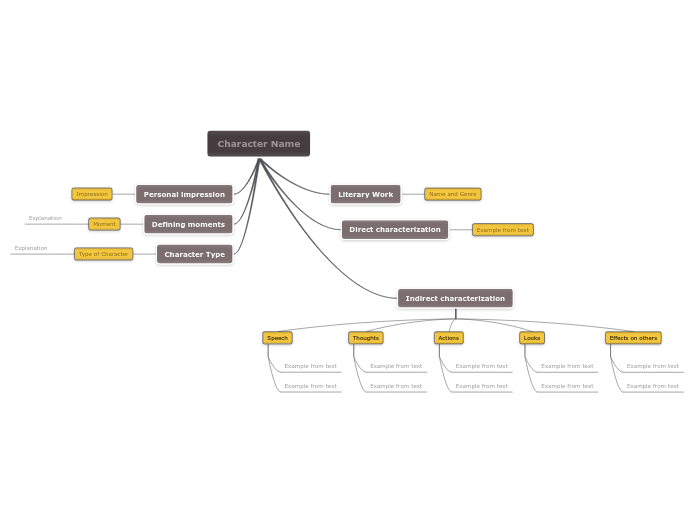Character Analysis Example
This mind map will help you make a character analysis based on the text of your literary work.
Keywords: character, literature, writing, characterization


Mais informações
Learn how to do a characterization study using this template. Make a direct and indirect characterization for the character you are analyzing.
For the direct characterization, you can look at the paragraphs where the author tells about the character’s personality and looks.
You can make the indirect characterization by looking at the thoughts expressed by the character, actions, and the effects of his actions in relation to others.
Find out what is the character’s role in the story, what are the events that affected the character’s evolution and in the end write your personal thoughts about the character.
Who is your character?
Type in the name of the character you are going to analyze.
What is the character's role in the story?
Examples:
- Protagonist: the main character in a literary work
- Antagonist: the main character that opposes the protagonist in a literary work
- Flat character: reveals only one or two personality traits, and the trait(s) does (do) not change
- Round character - a well-developed character who demonstrates varied and sometimes contradictory traits
Explain the role played by the character
Type in one or two sentences.
Example: Jake Kersey is now a private detective on the trail of art theft criminals. At the beginning of the story, Jake was presented as one of the most prolific art thieves of his generation. In this case, Jake is a round, dynamic character.
What were the events that affected the character's evolution the most?
Example:
Type in a short explanation to emphasize the importance of each particular moment you listed.
Example:
'Collin left childhood and became a real man at age 11. That is when his father left to war leaving him in charge of his mother and 4 little sisters.'
What do you feel about the character?
Type in the answers.
Indirect characterization
The writer can also reveal his character's personality by presenting the character's thoughts, words, actions, and also the way other characters relate to them.
How do other characters react in your character's presence?
Type in a relevant quote.
Example: 'Anna is my best friend and the kindest person I have ever met. There is nothing I wouldn't do for her. At times, I feel I love her more than my own sister.'
What is the character's appearance?
How are their clothes? Is he/she elegant? Type in a quote that reveals the character's looks.
Example: 'You must think I am insane spending so much on this, but it's a gorgeous dress. I think it's the best silk I have ever seen. And the color...Is it pink or magenta? I can never tell. I'll wear it with my pearls and diamonds necklace.'
What does the character do?
Type in a quote.
Example: 'I'm sorry Miss Klein, but this seat is taken! said Willie, as he pushed the old lady aside, crushing her dandelions.'
What are the character's private thoughts?
Type in a quote that reflects the character's way of thinking.
Example: 'I was looking at all those expensive gifts, but all I could think of was that poor old man I talked in the afternoon. When was the last time he had a decent meal? If I sold all my fancy clothes, how many loaves of bread and cans of milk could I buy him?'
What does your character say?
Type in a quote that shows the way the character's speech reflects their personality.
Example: 'You're an obnoxious little shaver, aren't you? Go clean those filthy hands at once! shouted Mrs. Greyjoy.'
Direct characterization refers to the process by which the writer tells the audience about the personality and looks of its character.
What does the writer tell you about the character's personality and looks?
Add several quotes that support the direct characterization of your character. Look for descriptive adjectives, phrases or epithets.
Example: The little girl was wearing a burgundy silk dress, with black stockings. Her hair was like fire but tamed in a pony tale. Although young, she had such mature presence.'
What is the name and genre of the literary work in which the character appears?
Examples:
- Novel: The Great Gatsby by F. Scott Fitzgerald
- Poem: The Raven by Edgar Allan Poe
- Drama: Macbeth by William Shakespeare
Os mapas mentais ajudam você a fazer brainstorming, estabelecer relações entre conceitos, organizar e gerar ideias.
No entanto, os modelos de mapas mentais oferecem uma maneira mais fácil de começar, pois são estruturas que contêm informações sobre um assunto específico com instruções de orientação. Em essência, os modelos de mapas mentais garantem a estrutura que combina todos os elementos de um assunto específico e servem como ponto de partida para o seu mapa mental pessoal. Eles são um recurso para fornecer uma solução prática para criar um mapa mental sobre um determinado tema, seja para negócios ou educação.
Mindomo traz modelos de mapas mentais inteligentes que permitem que você funcione e pense sem esforço.
Tópicos descritivos
Tópicos com texto de fundo
Filial padrão
Removendo os dados do modelo
Você pode escolher entre uma variedade de modelos de mapas mentais das contas comerciais ou educacionais da Mindomo, ou pode criar seus próprios modelos de mapas mentais do zero. Qualquer mapa mental pode ser transformado em um modelo de mapa mental adicionando mais notas de orientação a um de seus tópicos.